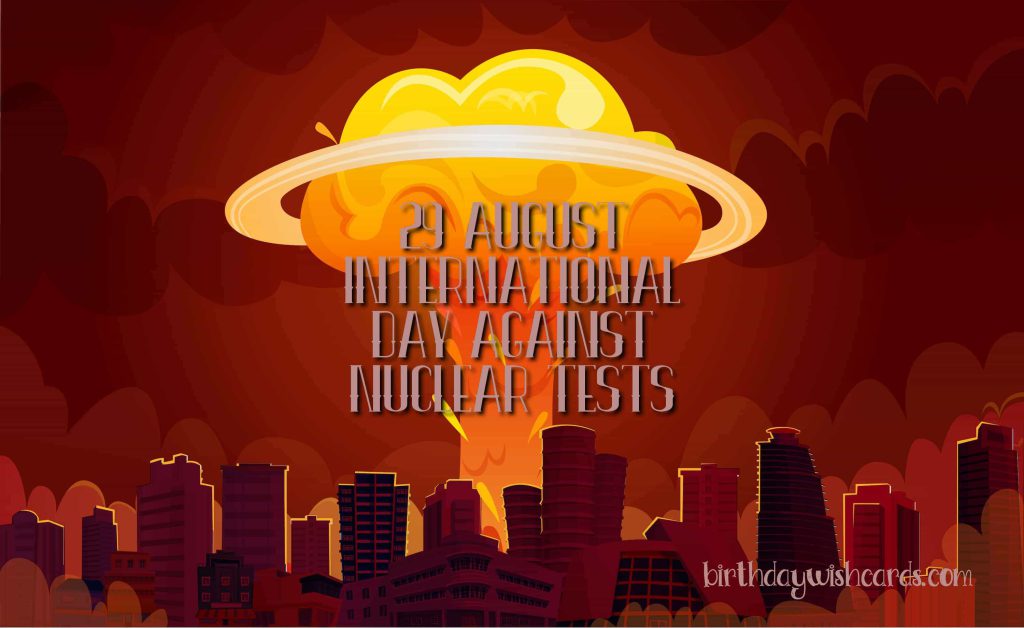29 August: International Day Against Nuclear Tests
The Impact of Nuclear Testing Worldwide
Since the first nuclear weapon test on 16 July 1945, nearly 2,000 nuclear tests have been conducted across the globe. In the early years, little attention was paid to the catastrophic effects on human health and the environment—particularly the dangers of nuclear fallout from atmospheric tests. Over time, mounting evidence has revealed the devastating and tragic consequences of nuclear weapons testing, especially when experiments went awry. Today, nuclear weapons are far more powerful and destructive than those used in early tests, making the risks even greater.
Origins of the International Day Against Nuclear Tests
On 2 December 2009, the United Nations General Assembly unanimously adopted resolution 63/35 during its 64th session, officially designating 29 August as the International Day Against Nuclear Tests. This resolution underscores the importance of raising awareness and educating the public about the devastating effects of nuclear weapon test explosions, and the urgent need to end all nuclear tests as a crucial step toward a nuclear-weapon-free world.
The initiative was led by the Republic of Kazakhstan, together with numerous sponsors and cosponsors, to commemorate the closure of the Semipalatinsk Nuclear Test Site on 29 August 1991. As one of the largest Soviet nuclear test sites, Semipalatinsk became a powerful symbol in the global movement for nuclear disarmament.
How the International Day Against Nuclear Tests is Observed
The first observance of the International Day Against Nuclear Tests took place in 2010. Since then, a wide range of events have been organized annually around the world, including:
- Symposiums and panel discussions on nuclear disarmament
- Public meetings and awareness campaigns
- Competitions, lectures, and educational programs
- Media campaigns and press releases
- Advocacy initiatives promoting peace and security
These activities aim to engage governments, civil society, and the public in the shared goal of banning nuclear tests and advancing global peace.
Bilateral and multilateral initiatives at the governmental level, alongside extensive civil society movements, have reinforced the worldwide momentum to end nuclear testing.
Additionally, the United Nations General Assembly designated 26 September as the International Day for the Total Elimination of Nuclear Weapons. Established in 2014, this day complements the International Day Against Nuclear Tests by mobilizing global efforts toward the complete elimination of nuclear weapons and fostering a world free of nuclear arms.
The Comprehensive Nuclear-Test-Ban Treaty (CTBT)
Adopted in 1996, the Comprehensive Nuclear-Test-Ban Treaty (CTBT) is the most far-reaching international legal instrument aimed at banning all nuclear explosions, whether for military or civilian purposes. Despite broad international support, the CTBT has not yet entered into force due to pending ratifications by key states.
As outlined in the Secretary-General’s 2018 disarmament agenda, Securing Our Common Future, the norm against nuclear testing advances both disarmament and non-proliferation. By prohibiting the development of new nuclear weapons, the CTBT helps prevent arms races and serves as a strong barrier against states seeking to develop or acquire nuclear weapons in violation of non-proliferation commitments.
The United Nations continues to urge all remaining states required for the CTBT’s entry into force to sign and ratify the Treaty without delay. Achieving this milestone is essential to maintaining the Treaty’s relevance and strengthening the global framework for nuclear disarmament.
The United Nations’ Commitment to Nuclear Disarmament
The United Nations envisions a future free from nuclear weapons. Until that vision is realized, the International Day Against Nuclear Tests serves as a vital reminder of the ongoing efforts needed to promote peace and security worldwide.
Since the dawn of the nuclear age, civil society has played a pivotal role in advocating for a complete halt to nuclear testing. Diverse groups—including physicists, seismologists, medical professionals, lawyers, women’s organizations, research institutes, NGOs, politicians, and survivors of nuclear bombings—have all contributed to shaping public understanding and policy approaches to nuclear disarmament.
Global Efforts to Ban Nuclear Testing
In recent decades, civil society’s campaign for a comprehensive ban on nuclear testing has been closely linked to the broader goal of eliminating nuclear weapons altogether. To ensure the CTBT enters into force, NGOs, civil society organizations, and individuals worldwide are encouraged to advocate for their governments to sign and ratify the Treaty.
These groups also promote the United Nations Secretary-General’s Five Point Proposal for Nuclear Disarmament, which includes:
- Bringing the CTBT into force
- Negotiating a nuclear weapons convention supported by a robust verification system
- Implementing additional measures for global nuclear disarmament and non-proliferation
Such initiatives are vital for building momentum and political will toward a nuclear-weapon-free world.
Milestones in Nuclear Testing Awareness and Bans
- 1950s: Physicians and women’s groups raised public awareness about the health impacts of atmospheric nuclear testing, including the discovery of radioactive isotopes in children’s teeth. Their activism contributed to the Partial Test Ban Treaty of 1963, which prohibited nuclear tests underwater, in the atmosphere, and in outer space—though underground testing was still permitted.
- 1980s: Joint US-Russian scientific experiments demonstrated the feasibility of verifying bans on underground nuclear tests. This era also saw mass protests against nuclear testing at the Nevada Test Site in the United States and the rise of the Nevada-Semipalatinsk Movement in Kazakhstan, opposing Soviet tests at Semipalatinsk.
- 1980s–1990s: High-profile campaigns targeted French nuclear tests at Mururoa Atoll in the Pacific Ocean, raising global awareness and opposition to nuclear testing.
- 1985 onward: NGOs lobbied intensively during Nuclear Non-Proliferation Treaty (NPT) review conferences to secure commitments toward a Comprehensive Nuclear-Test-Ban Treaty, a goal reaffirmed at the 1995, 2000, and 2010 NPT review conferences.
- 1990s: NGOs and parliamentarians initiated a 1991 conference focused on amending the Partial Test Ban Treaty to make it comprehensive, laying important groundwork for CTBT negotiations.
- Non-governmental researchers made significant contributions to the development of verification technologies essential for monitoring compliance with nuclear test bans.
- NGOs played a critical role in monitoring and influencing the negotiations that led to the CTBT’s adoption in 1996.
- Ongoing NGO campaigns continue to encourage governments to

